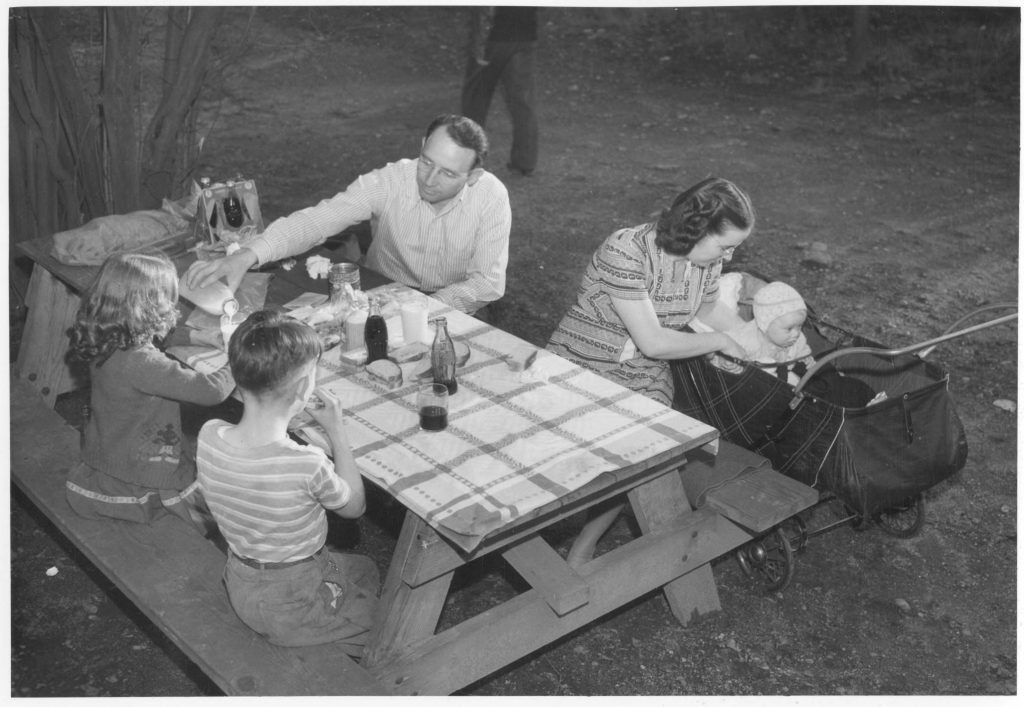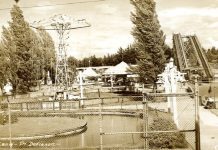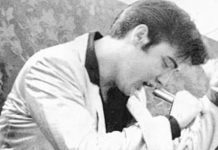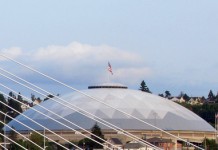When sunny days break through the Pacific Northwest’s usual clouds and rain, parks beckon as places of relaxation and recreation. During the early twentieth century, people from Tacoma flocked to the city’s new Point Defiance Park, where they could escape the city and enjoy what the great outdoors had to offer. Many packed a picnic along.
Point Defiance Park
In 1888, the city of Tacoma acquired the Point Defiance Military Reservation, which had been set aside for a military installation that was never built. While ownership was not formally transferred to the city until 1905, the park quickly became a popular destination.
A streetcar line connected to the park in 1890, increasing accessibility. Local steamboats also made daily runs to the park. A short walk from the pagoda, built in 1914 as a streetcar and later bus stop, led to the zoo, gardens and down to the waterfront. The areas near the pagoda and the waterfront were popular picnicking spots at the time.

Where to Picnic at Point Defiance Park
Picnic grounds were constantly being maintained and fixed up at the park. “General improvement of and establishment of more picnic grounds was emphasized in all the parks this year,” reported George Hill, park superintendent, to the Tacoma Daily Ledger on March 25, 1912, “….the old picnic grounds on the right of the main highway, and above the pavilion have been leveled, the stumps removed, and new paths leading to them constructed. On the lower path, cut in the bluff above the beach, small picnic grounds with tables and a bench or two have been provided in several places.”
A promenade connected the pavilion, which had a restaurant and concession stands selling ice cream and roasted peanuts, to Owen Beach, earning the beach the nickname “new beach” or “picnic beach.”

Having a Point Defiance Park Picnic
Groups such as clubs and churches, as well as friends and families from all over Tacoma and the region, held picnics at the park, often meeting at the streetcar stop and walking to their destination, carrying what they needed with them. Picnics could include games, speeches and even dances. Or they could be as simple as people bringing their baskets and enjoying eating around a bonfire on the beach after an evening of boating, like the friends of Henrietta Newman did before she left for an extended visit to her sister in 1911.
Many of these events were annual, such as summer gatherings of residents originally from other states. In 1913, 200 former Ohio state residents came together for a picnic with speeches from Iowa guests and music.
These picnics could be times of reconnecting and friendship. In 1917 the park was the scene of an emotional reunion between brothers Isaac and William Murray, who had not seen each other since 1875. Both members of the GAR, these elderly veterans, lived in soldier’s retirement homes nearby.
Some gatherings were for children in need, like the annual summer picnic held for the Children’s Industrial Home. Run by volunteers, besides a lunch picnic, the children from “The Home on the Hill” could enjoy games and visit Funland amusement park and the zoo. There was an annual cruise on the Sound followed by ice cream and balloons.

Early Twentieth-Century Picnic Fare
Even at group picnics, people tended to bring their own food while the organizers served coffee hot off the cookstove. At a potluck for the Sixth Avenue Baptist Church organized by women’s auxiliary clubs, the North Circle brought salads, the west hot dishes and the east desserts and rolls to keep the menu balanced.
Sandwiches were the turn-of-the-century favorite for picnics. A 1905 Tacoma News Tribune listed a series of “tasty picnic recipes,” all of them sandwiches. They included chicken and nut, walnut, deviled egg, roast beef, peanut, stuffed eggs, chicken salad, ham and olive, and egg salad. The peanut sandwich used a type of homemade peanut butter, “Shell and skin freshly roasted peanuts,” the recipe said, “and roll them to fine crumbs on a pastry board. Add salt to taste and mix the powdered nuts with enough fresh cream cheese to make a paste that can be easily spread on unbuttered bread.”
Others cooked at the park, sometimes holding salmon and clam bakes. These events proved quite popular. Two sacks of clams proved not enough for a crowd of 500 at a 1941 clambake held by the Illinois Association of Pierce County.
Picnics proved a popular form of affordable entertainment during the Great Depression. Point Defiance Park could then be a busy place. Club listings in the Tacoma News Tribune on August 8, 1939, indicated three major picnics were scheduled by the Tacoma Woman’s Study, Luella Joy and Philomathea Clubs.
During World War II, Point Defiance Park also provided a place for military-related gatherings. In August 1941, the Tacoma Navy Mother’s Club reserved a spot near the bandstand for their annual picnic. Supplying coffee and ice cream, families brought picnic baskets, enough to share with sailors. All naval members were invited, even if they did not call Tacoma home.
Point Defiance Park Then and Now
While many things have changed since the early twentieth century, Point Defiance Park remains one of Tacoma’s most beloved places. With the Point Defiance Zoo and Aquarium, Fort Nisqually Living History Museum, Point Defiance Marina, Rose Garden, and so much more, the park has something for everyone. Happy picnicking this summer!








































